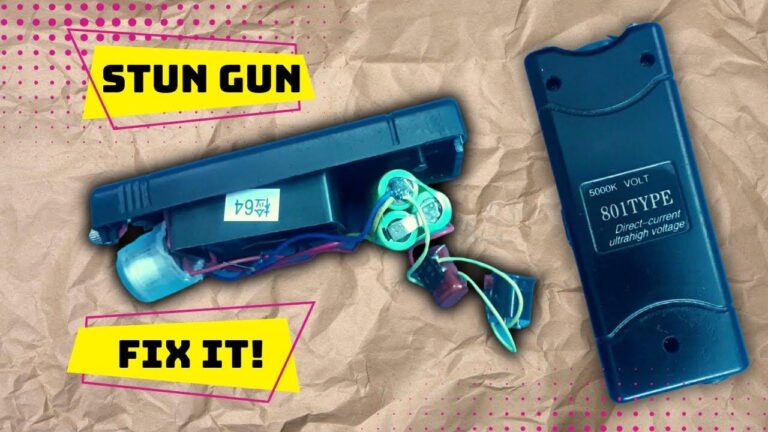Table of Contents
- Understanding Common Reasons Your Stun Gun May Fail Unexpectedly
- Step by Step Troubleshooting Techniques to Diagnose the Problem
- Essential Maintenance Practices to Prevent Future Device Malfunctions
- When to Seek Professional Repair or Consider Replacing Your Stun Gun
- Key Takeaways
Understanding Common Reasons Your Stun Gun May Fail Unexpectedly
Stun guns are powerful self-defense tools, but like any electronic device, they can fail at critical moments. One of the most common issues is battery depletion. Over time, batteries lose their charge, and if the stun gun hasn’t been regularly recharged or replaced, it may not deliver the necessary electrical shock. Another frequent culprit is dirty or corroded contacts. Exposure to dust, moisture, or sweat can affect the metal electrodes, causing the stun gun to malfunction when you need it most. Simple maintenance, such as cleaning the contacts with a dry cloth and ensuring the device is dry before use, can significantly reduce this risk.
Electrical components inside the stun gun may also suffer from internal wiring issues or component wear, especially if the device has been dropped or exposed to extreme conditions. Additionally, some stun guns come with safety switches or trigger locks that users might accidentally engage without noticing, preventing the device from firing. It’s important to familiarize yourself with all operational features and perform routine checks. To avoid unexpected failures, keep your stun gun stored in a cool, dry place, inspect it regularly, and never ignore strange sounds or weak shocks during tests.
Step by Step Troubleshooting Techniques to Diagnose the Problem
Begin by performing a visual inspection of your stun gun. Check if the battery is properly seated and charged-sometimes the simplest cause is a depleted or loose battery connection. Look for any visible damage such as cracks, corrosion on terminals, or loose internal components. Next, ensure the safety switch is set correctly; many devices won’t activate if the safety is engaged. If your stun gun uses replaceable batteries, try swapping them out with fresh ones to rule out power issues before diving deeper.
If the initial checks don’t resolve the issue, move on to testing your stun gun’s functionality systematically. Use a multimeter to verify the battery voltage and confirm it meets the required threshold. Then, test the output terminals for a spark in a safe environment-never touch the probe ends during this step. If no spark appears, reset the device if possible or consult the manufacturer’s manual for any internal fuse or circuit breaker that may have tripped. Keep a checklist handy to ensure you don’t overlook minor details, as sometimes a small, forgotten step is the key to diagnosing the problem efficiently.
Essential Maintenance Practices to Prevent Future Device Malfunctions
To ensure your stun gun remains reliable when you need it most, adopting a regular care routine is crucial. Start by cleaning the device’s electrodes and casing with a soft cloth and a mild alcohol solution to avoid any residue buildup that might interfere with its function. Avoid using abrasive materials or harsh chemicals, as they can damage the internal components. Additionally, always store your stun gun in a dry environment, away from extreme temperatures and moisture, which can cause corrosion or degrade battery performance over time.
Another vital aspect of maintenance is routine battery checks and replacements. Keep in mind that even unused batteries can lose power gradually. Test your stun gun’s battery at least once a month and replace it according to the manufacturer’s guidelines or when performance drops. Furthermore, ensure that the stun gun’s safety features, such as locks and triggers, are operating smoothly to prevent accidental discharges or malfunctions. By following these simple yet essential habits, you can dramatically reduce the risk of unexpected device failure and ensure your personal safety device is always ready.
When to Seek Professional Repair or Consider Replacing Your Stun Gun
When your stun gun unexpectedly stops working, it’s essential to evaluate whether the issue is something you can fix yourself or if professional intervention is necessary. If you notice any of the following signs, it’s best to consult a qualified technician:
- Visible damage to the electrodes or casing that appears beyond superficial wear
- Persistent electrical malfunctions that don’t improve after charging or battery replacement
- Burnt smells or unusual noises during operation, suggesting internal short circuits
At times, the cost and effort required for repairs might outweigh the benefits, making replacement the smarter option. Consider investing in a new stun gun if:
- The device is more than a few years old and frequently malfunctioning
- Replacement parts are hard to find or prohibitively expensive
- Your stun gun no longer meets your security needs or features modern safety upgrades
Key Takeaways
Dealing with a stun gun that suddenly stops working can be unnerving, especially when you rely on it for personal safety. By staying calm, performing basic troubleshooting, and ensuring regular maintenance, you can often resolve common issues and get your device back in action quickly. However, if the problem persists, don’t hesitate to consult the manufacturer or a professional technician to avoid compromising your security. Remember, understanding how to properly handle and care for your stun gun not only extends its lifespan but also ensures it performs reliably when you need it most. Stay prepared, stay safe!Check Our Other Blogs
- StunGun – Your Trusted Source for Stun Guns, Laws, and Self-Defense Tips
- PepperSprayLaws – Your Trusted Resource for Pepper Spray Information
- StunGunLaws – Your Trusted Guide to Stun Gun Legality and Safety



